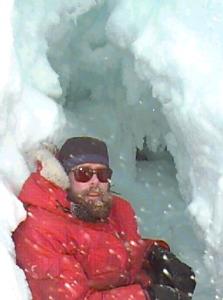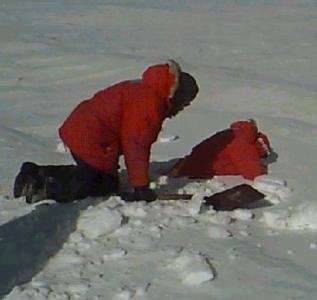26 December, 1996
Craig Marshall is one of the scientists who are trying to understand the
chemistry responsible for keeping fluid in the cells of Antarctic fish from
freezing. He is from New Zealand and stands out in a crowed because he walks
around in short pants. I think he has injected some of the antifreeze from
the fish he studies into his own blood.
Most organisms don't maintain a body temperature, their bodies are at the
same temperature as the environment they. Mammals are actually an exception.
The fish living in McMurdo Sound have body temperatures below zero degrees
Celsius! They maintain normal metabolisms and respiration at temperatures
where the fluid in their cells would be expected to begin to solidify. Even
though ice begins to form, Craig feels that proteins in the blood change
their shape and prevent the crystals from growing larger.
If ice crystals form in an environment where the concentration and movement
of water molecules is low, like in the cells of a fish, their form will take
a unique hexagonal shape. These can not be grown in a laboratory and are too
small to extract from the fish. They have only been found in forms large
enough to study in a few places on the planet. One of the places is a
crevasse in Antarctica. Since Craig needed to know more about their
structure, we were off in search of the perfect ice crystal.
In McMurdo Sound there is a permanent ice shelf about three hundred feet
thick, and sea ice, about fifteen feet thick. Where they meet is called the
transition. The sea ice moves with the tides while the permanent ice is
reasonably stationary. The difference in movement cause long crevices to
form at the boundary. These crevices become covered with blowing surface ice
and are very difficult to find unless you have the misfortune of falling
into one. We hoped to find the transition area, dig through the surface ice,
get lowered into the crevasse and find a passage that would lead to an area
containing large undisturbed perfectly formed ice crystals. I've included a
picture of Miles digging into a crevasse and Buck inside the long chamber we
found once inside.
The biggest problem for me once inside was to try not to think about the
fact that I was no longer being belayed and completely out of contact with
my companions above. Once I found an area with ice crystals, I lost all
sense of concern. They were unlike anything I have seen. They were perfectly
clear, paper thin, and hexagonal is shape. They would have made perfect
Christmas tree ornaments. Because they were so clear I couldn't photograph
them so I decided I would eat them. They were like very fine delicate
crunchy potato chips. I don't know how Craig would have reacted if he knew I
was eating the samples he had traveled so far to collect.

Buck in a crevasse

Searching for the transition
Contact the TEA in the field at
.
If you cannot connect through your browser, copy the
TEA's e-mail address in the "To:" line of
your favorite e-mail package.
|
